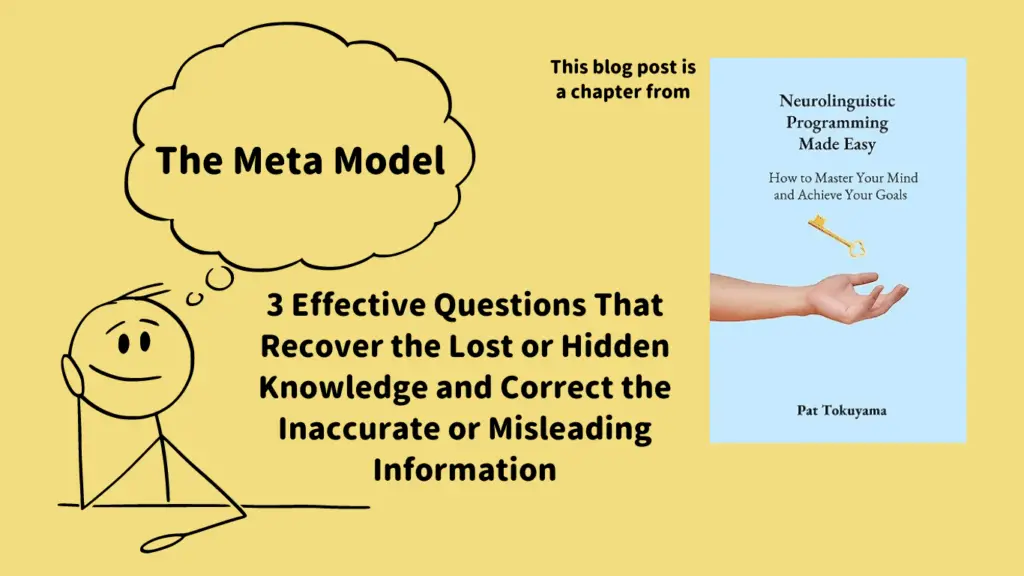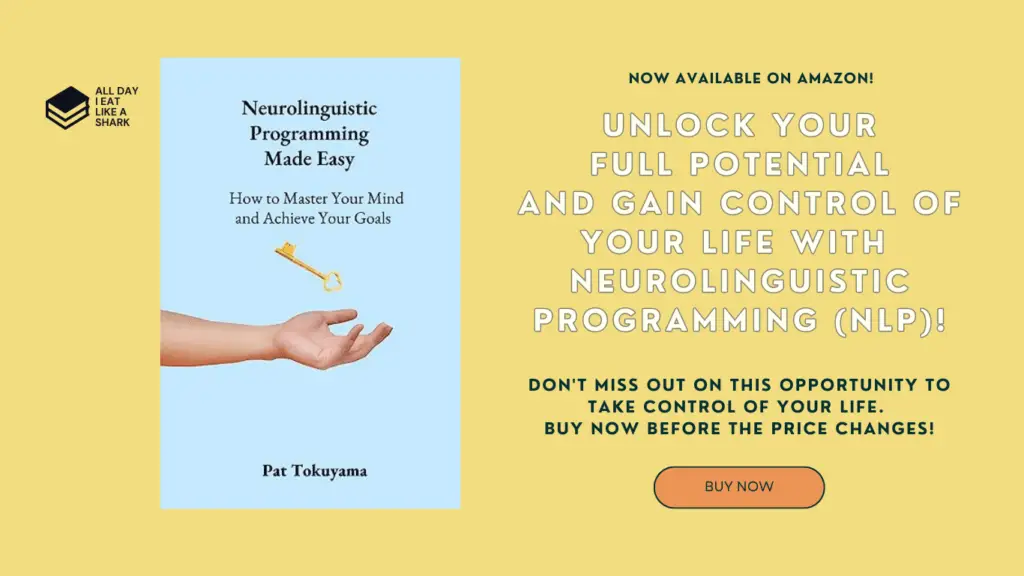
This is the first chapter of the Neurolinguistic Programming Made Easy: How to Master Your Mind and Achieve Your Goals by Pat Tokuyama
Guide to the Good Stuff
Have you ever wondered how your words affect your reality? How the way you speak and think influences your feelings, behaviors, and actions?
The Meta Model is a tool that helps you understand and change the way you use language and how it affects you and others.
The Meta Model is based on the idea that our language reflects our internal representations, which are composed of sensory modalities: visual, auditory, kinesthetic, olfactory, and gustatory. These internal representations are not accurate copies of reality, but rather subjective interpretations that are filtered, distorted, generalized, and deleted by our beliefs, values, memories, experiences, etc.
The Meta Model helps us identify and challenge the distortions, generalizations, and deletions in our language and thinking that limit our communication and perception. These patterns often lead to confusion, misunderstanding, conflict, or lack of clarity.
The Meta Model is a set of questions that help you clarify and challenge the language patterns that distort, delete, or generalize information. The Meta Model is based on the idea that you can use language to recover the lost or hidden knowledge and to correct the inaccurate or misleading information. The Meta Model helps you understand yourself and others better, solve problems, resolve conflicts, and achieve your goals.
The Meta Model questions can be grouped into three categories
1. Questions that challenge distortions
These questions help us test the validity or accuracy of our statements that imply a causal relationship, a mind reading, a lost performative, or a presupposition. For example:
- “How do you know that?” (challenges a mind reading)
- “According to whom?” (challenges a lost performative)
- “What specifically?” (challenges a presupposition)
2. Questions that challenge generalizations
These questions help us examine the scope or extent of our statements that use universal quantifiers, modal operators of necessity, or modal operators of possibility. For example:
- “Always? Never? Everyone? No one?” (challenges a universal quantifier)
- “What would happen if you did? What would happen if you didn’t?” (challenges a modal operator of necessity)
- “What stops you? How do you know you can’t?” (challenges a modal operator of possibility)
3. Questions that challenge deletions
These questions help us fill in the gaps or details of our statements that use nominalizations, unspecified verbs, simple deletions, lack of referential index, or comparative deletions. For example:
- “What specifically?” (challenges a nominalization)
- “How exactly?” (challenges an unspecified verb)
- “Compared to what?” (challenges a comparative deletion)
In this chapter, you’ll learn more about how to use the Meta Model questions to improve your communication and perception. By the end of this chapter, you’ll have a powerful insight to change your feelings and thoughts, and to communicate more effectively and persuasively with others.
How to use the Meta Model
To use the Meta Model, you need to pay attention to the words and phrases people use when talking or thinking. You can identify the three types of Meta Model violations that distort, delete, or generalize information. Review some of the examples I provided below to become familiar with them.
1. Distortion
Changing or twisting the meaning of something.
1.1 Mind Reading
We often assume we know what others are thinking or feeling, as if we’ve somehow developed the ability to read minds. When we say, “You don’t like me,” we’re not only making an assumption about someone else’s emotions, we’re also creating a reality that may not exist. The risk here is that our assumptions could be completely wrong, and we end up creating problems that were not there to begin with.
1.2 Lost Performative
This pattern occurs when we make value judgments without attributing the source of the judgment. “It’s bad to be inconsistent” is an example. Who says so? By whose standards? Here, the risk is that we might take these judgments as absolute truths, without ever questioning their origin or validity.
1.3 Complex Equivalence
In this pattern, we interpret two experiences as being synonymous, such as “She’s always shouting at me, she doesn’t like me.” Here, we’re linking one action directly to an emotion, creating a reality that might not exist. We must remember that people’s actions are often more about them than they are about us.
1.4 Presuppositions
These are unverified assumptions we make in our statements. They’re often so subtle that we don’t even realize we’re making them. By recognizing these hidden assumptions, we can shed light on our underlying beliefs and challenge them if necessary.
2. Deletion
Leaving out or omitting something.
2.1 Nominalizations
These are processes or actions turned into vague concepts, as in “There is no communication here.” By clarifying these nominalizations, we can bring the conversation back to specific actions and realities.
2.2 Unspecified Verbs
These are verbs that lack specific definition, like “He rejected me.” What exactly does “rejected” mean in this context? By asking for specifics, we can get a clearer picture of the situation.
2.3 Simple Deletions
These are statements that lack specific information. For example, “She left” is a deletion of “She left because she was angry.” By probing further, we can understand the true cause or what really happened, were a camera to have captured the action.
2.4 Lack of Referential Index
These are statements that don’t specify who or what is being referred to. When we say, “They don’t listen to me,” who are ‘they’? By clarifying these references, we can make our communication more precise and effective.
2.5 Comparative Deletions
These are comparisons made without a reference point. “She’s a better person” begs the question, better than whom? By pinpointing the reference for comparison, we can gain deeper insights and clarity.
3. Generalization
Making a broad or universal statement based on a single or limited experience.
3.1 Universal Quantifiers
When we use terms like “never” or “always,” we are generalizing our experiences. For example, “I always fail” is a generalization of “I failed this test.” While this can simplify our understanding of the world, it can also limit us. By challenging these universal quantifiers, we can open up to a richer, more nuanced view of reality.
3.2 Modal Operators of Necessity
These expressions of obligation can sometimes make us feel trapped or powerless. When we say, “I have to take care of her,” we might be failing to consider other options or possibilities. Remember, there’s always a choice. And when you can recognize that in a situation where it doesn’t feel like it, it brings the power back to you and enables you to do something different had you not recognized that pattern.
3.3 Modal Operators of Possibility
These expressions reflect our perceived limitations. “I can’t tell him the truth” is a statement that places a limit on our capabilities. By challenging these modal operators of possibility, we can often find that we are more capable than we think.
These patterns, once recognized and understood, can be used as tools for personal growth and transformation. They are not just abstract concepts but powerful keys to unlock the door to clearer communication and healthier beliefs. Remember, the words we use shape our realities. By becoming more aware of our language patterns, we can start to craft a reality that aligns more closely with our true desires and aspirations.
Once you’re able to recognize the Meta Model violations, you can to ask specific questions that help you recover or challenge the information. Use the three types of Meta Model questions that correspond to the three types of Meta Model violations. Here are a few questions to help you get started.
Three types of Meta Model questions
1. Distortion questions
Questions that help you clarify or test the validity of something. For example, “How do you know he hates you?” or “What would happen if he didn’t hate you?” are distortion questions for “He hates me.”
2. Deletion questions
Questions that help you fill in the missing information or specify something. For example, “Who left?” or “Why did she leave?” are deletion questions for “She left.”
3. Generalization questions
Questions that help you explore the exceptions or alternatives to something. For example, “When did you succeed?” or “How could you succeed?” are generalization questions for “I always fail.”
By asking these questions, you can help yourself and others to communicate more clearly and accurately, to understand each other’s perspectives and needs better, and to find solutions and possibilities more easily.
How to practice the Meta Model
One way to practice the Meta Model is to use it on yourself when you notice yourself using language patterns that distort, delete, or generalize information.
For example, if you catch yourself saying or thinking something like “I’m not good enough,” you can ask yourself distortion questions like “What does good enough mean?” or “According to whom?”
You can also ask deletion questions like “Not good enough for what?” or “Compared to what?”
You can also ask yourself generalization questions like “When were you good enough?” or “What would make you good enough?”
Another way to practice the Meta Model is to use it on others when you notice them using language patterns that distort, delete, or generalize information.
For example, if someone says something like “You don’t care about me,” you can ask them distortion questions like “How do you know I don’t care about you?” or “What would show you that I care about you?”
You can also ask them deletion questions like “Don’t care about you in what way?” or “What are you expecting from me?”
You can also ask them generalization questions like “Is there a time when I cared about you?” or “What could I do differently to make you feel cared for?”
When using the Meta Model on others, it is essential to be respectful and empathetic. You don’t want to sound like an interrogator or a critic. You want to remain curious and be a supportive listener.
You want to use a gentle and friendly tone of voice and body language. Use the Meta Model as a tool for understanding and helping, not for judging and blaming.
Summary
In this chapter, you learned about the Meta Model, a set of questions that help you clarify and challenge the language patterns that distort, delete, or generalize information.
You learned how to identify the three types of Meta Model violations and how to ask the three types of Meta Model questions. You also learned to practice the Meta Model on yourself and others to improve your communication and perception.
Just as a sculptor chips away at a block of stone to reveal the masterpiece within, we too can use the Meta Model to chip away at the distortions, generalizations, and deletions in our communication. As we do this, we begin to expose limiting beliefs and clarify our understanding of ourselves and the world around us.
In the end, it’s all about awareness. The more aware we are of our own language patterns, the more control we have over our thoughts, emotions, and actions. The Meta Model isn’t just a tool for communication; it’s a tool for life. As we journey down this path of self-discovery, remember to be patient and kind to yourself. Change takes time, but with persistence and understanding, you can transform your reality one word at a time.
In the next chapter, you’ll learn about the Milton Model, a set of linguistic patterns that help you communicate with the unconscious mind and suggest changes.
